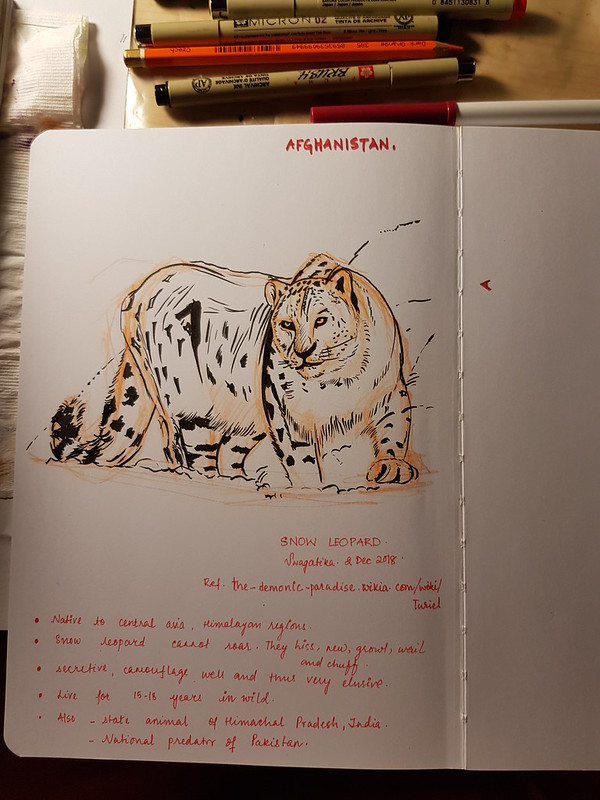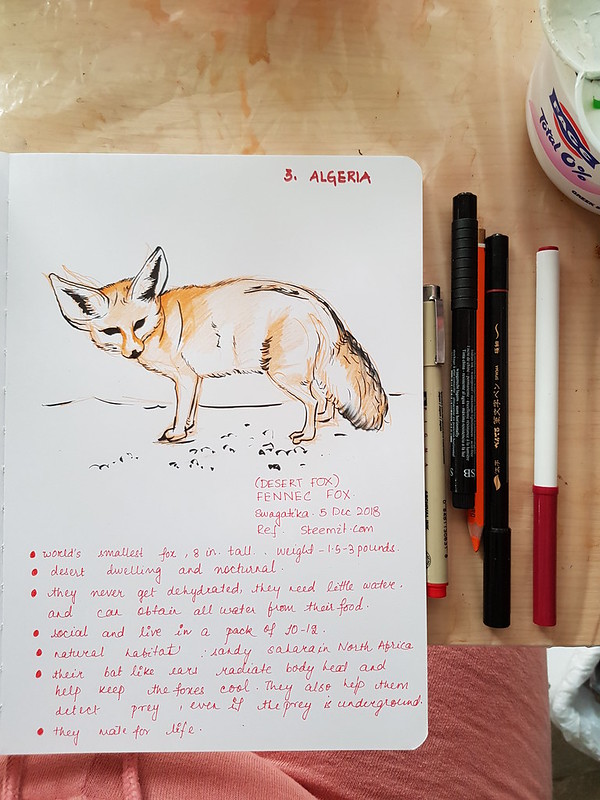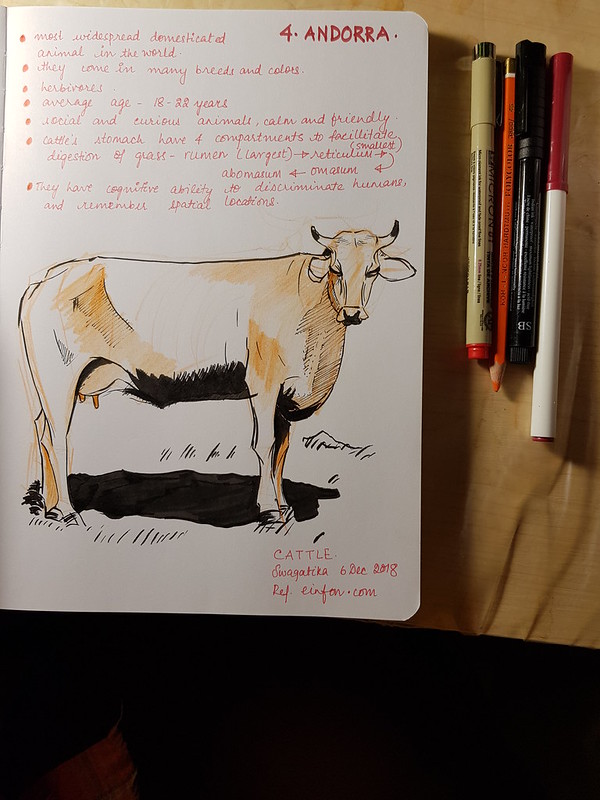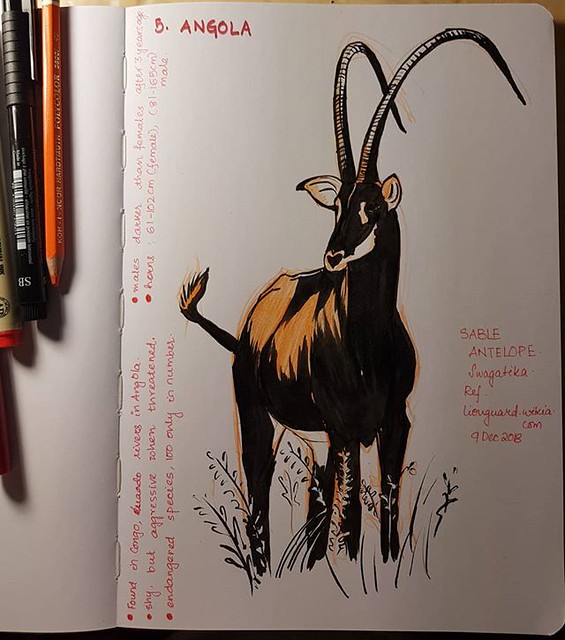I went to Portland recently, and met an amazing artist after a gap of two years. She told me that one of her paintings is being showcased in an exhibition in an art gallery. We went there after a full satisfying lunch. It was a very fullfilling experience in the gallery. There were nice paintings showing the theme of conserving trees. It was interesting that each artist had a very unique style of painting the same subject. There were also large oil paintings on wooden panels for an ongoing project to preserve America's coast line, again reflecting uniqueness of each artist. But the most appealing things to both of us were the sketchbooks. There were a few tables where sketchbooks of different artists were being showcased. Each sketchbook was hooked onto an anchor securely so that visiters can browse through its pages conveniently without displacing the sketchbooks. One of the sketchbooks I saw caught my eyes. It was a tall book with top two-third portion in plain white for drawing, and bottom one-third with rules for writing. The artist had done beautiful, light botanical sketches, and wrote notes about them. I loved the idea. On my way back I kept thinking that I want to do something like that. And the idea of sketching national animals of each country stuck me. I think it was the impact of watching too many BBC Earth Netflix documentaries :D
The next day, I had to catch up with my chores and office work. But the idea kept popping in my head. I searched, and found there are 193 countries in the world, and if I start the project I have to do 193 sketches of the animals in order finish the project. I was itching to start the project, but was constantly stopping myself from doing it because I had other stuff to do. In the end, I could not resist. Finally at 12AM on the Sunday night I opened a new notebook, and started sketching on it. Well, that's me, waking up in the middle of the night to do something completely unimportant just because it has been bugging me.
The plan is as follows:
- I will sketch national animal of each country, by moving alphabetically from A to Z.
- I will stick to orange pencil and black ink to keep it simple, and keep my expectations low.
- I will restrict the orientation in portrait mode for ease of browsing.
- I will write a few notes about the animals next to the sketch.
So far, I am liking the effect. It has been very satisfying. On top of that, I feel like I am shooting 3 birds with one arrow. I can see how well I am sharpening my drawing and anatomy skills (Drawing). I am learning about different countries (Geography). I am also learning a lot about the animals I am sketching (Biology). A little bit of research goes on every time I sketch an animal, keeping the journey interesting.
My only fear is if I will be able to complete it. Knowing my nature, I am filled with many apprehensions. What if I get bored or distracted half-way through? What if I start putting too much pressure and procrastinate? What if I don't finish? If I do one sketch a day regularly, it will take me until mid-august 2019 to finish all the sketches. Honestly, that timeline is a little bit daunting and overwhelming. Well, that is the challenge I am going to face with this project. And fingers crossed for finishing it successfully.
My only fear is if I will be able to complete it. Knowing my nature, I am filled with many apprehensions. What if I get bored or distracted half-way through? What if I start putting too much pressure and procrastinate? What if I don't finish? If I do one sketch a day regularly, it will take me until mid-august 2019 to finish all the sketches. Honestly, that timeline is a little bit daunting and overwhelming. Well, that is the challenge I am going to face with this project. And fingers crossed for finishing it successfully.
A few days before I sketched the snow leopard, I watched an episode of "Tales by Light" of Netflix, where the photographer flies to Ladakh, India to catch a glimpse of Snow Leopards, and repeatedly said that the animal is "elusive". So, it was interesting to sketch the snow leopard. I instantly went into resonance, when I started sketching it. Developing the shape, outlining and shading using pencil, and defining edges and shadows using brush pen was very interesting. I felt very much in control. The feeling has sustained all over the 6 sketches I have done so far, thankfully. I loved the gaze of the Snow Leopard, focused, aggressive, and sharp. The black outline on its eyes reminded me of the black surma used by Afghan people.
As I sketched the anatomical framework, it was interesting to note how features of the animal have evolved to support it to adapt to its habitat. The paws have an extra padding to help walk in snow, the coat is white to help camouflage, the body is stocky, and lot of belly fat to protect against the cold. It was a good learning experience. I felt excited to learn more about the animals as I sketch them.
One thing I noticed that I was being anxious to finish the project right away. I was able to rationalize it soon though, and laughed at myself. Even if I stay up for 24 hours without doing anything else, I won't be able to complete this project. And here, I was somehow wanting to complete it right away. It is not a good approach towards work and projects. I have been noticing it since a few years. It also marks a shift from homework, exam, or competition based work demanding efforts in intense bursts to large projects demanding steady effort over time. I would like to expand more on the thought in another project. While, I am struggling with containing the urge to just finish everything, I think this project is also going to help me overcome this attitude.
Moving on to my next sketch, it was surprising to find that a bird is also categorized as an animal. It was the most time-consuming of the 6 sketches, but not tiring at all. I loved every bit of doing it. Bird shapes are different and more unfamiliar to me in comparison to animal shapes. I find it more comfortable to sketch animals since they have similarities to humans in anatomy. Birds on the other hand have different anatomy, and have very delicate contours. I loved the eyes though. I liked that I was able to capture the shininess. They have this intense, emotional, focused, angry eyes, I feel like if I encounter a golden eagle any time, I will just stare at its eyes. And yes, they are the second fastest bird in the world Perigree Falcon being the fastest. Now that I have done this much of research, I ask, "What is the difference between a falcon, and an eagle? And what about hawks and kites?" It turns out they are all different species. While eagles, hawks, and kites share same genealogy, falcons share the genealogy of parrots. Each of the species have their shapes and size defined in order to enable them to adapt the best to their environment. To learn more, check out this Quora post.
By the time I sketched the first two sketches, I developed the impression that, "All countries must be having powerful, aggressive, and predatory animals and birds as their national anmials, isn't it?" And my next sketch (and a few more sketches thereafter) proved me wrong. When I was browsing for photographs of Fennec Fox of Desert Fox, I thought it will be an animal of the size of a street dog. Turns out, it is really tiny! It is the smallest fox with size up to 8 inches. That was a quick breaking of my assumption! It was interesting how their ears helped them in both listening to preys, and also to help radiate heat. I am so enjoying this project!
I did not know where "Andorra" was. I went to search for "national animal of andorra" directly. And it shows cattle! Wait, does it mean cows, or anything else? Where is this country? I never thought cows will be national animal of any country. Turns out Andorra is a tiny buffer country between to large countries Spain and France, each with their own majestic history. Cattle are so useful and important part of their life, that they are declared as national animal of the country. Meanwhile, in India, we have reduced such an intelligent, gregarious, and economically beneficial animal into a topic of politics, standup comedies, and a stereotype defined by western tourists. Time to reconsider our priorities.
I loved the shiny brownish black coat of the Sable Antelope. This beautiful animal is an endangered species with only 100 numbers remaining as per 2015 census. Their large horns were very interesting to sketch. Although I had learned that antelopes and deer are different, I was not very sure how. But now ... I know. Read more here. Both male and female antelopes have horns. Only male deer have antlers. Antelopes' horns are permanent, whereas deer shed and grow them every year. Antelopes have a straight horns, whereas deer have branched horns, as we will see in out next sketch.
Do you see the branched out antlers? Yes, and that's how you tell that it is a deer. I guess fallow deer are not different from harina(ହରିଣ)s or hiran(हीरन)s. Originally from Euarasia,they were carried around to other parts of the world with colonialism, and migration. Introduced to the Americas in 1700s, they are now the national animal of Antigua and Barbuda, a tiny archipelago nation in West Indies.
I did feel a sense of pressure and tension by the time I sketched the Fallow Deer. So I decided, I should blog about them first, before moving on to the next half of countries that start with A.
Happy sketching! You can finish it!.






Yes you can...Keep the target in front of your mind...And all good creation required lots of patience...So keep doing.....☺️
ReplyDeletethank you nani... I will try to
DeleteWow Swagatika.. It's really nice to see sketches and reading ur blog. Good that u r managing your hobbies and interests along with job..
ReplyDeletethank you Tapi... they help me recharge... so I thought why not. Although it is still a little bit of struggle, I am enjoying it
DeleteThank you for taking the time to read ot
ReplyDelete